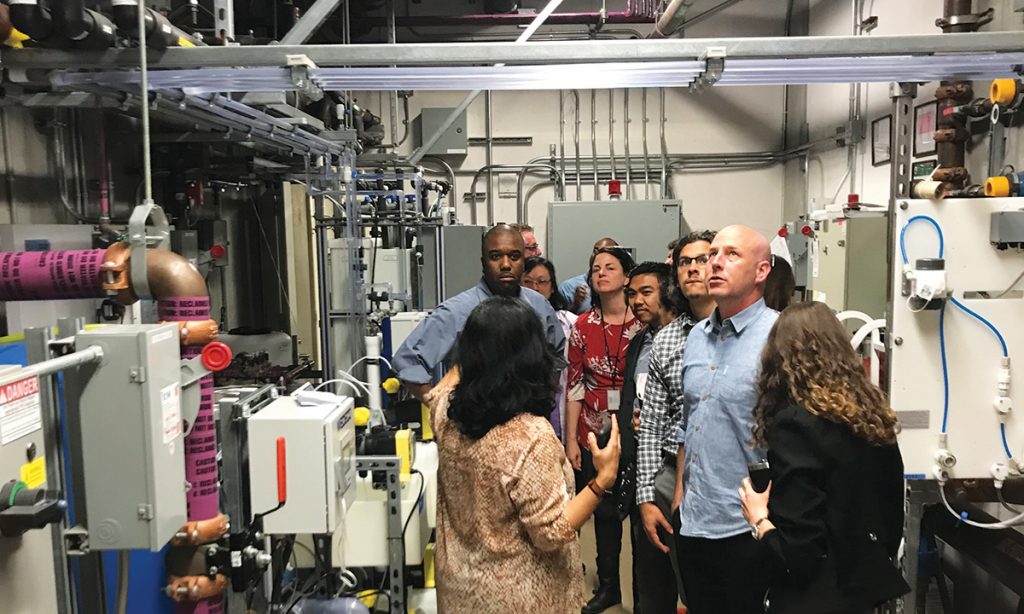
SFPUC headquarters has implemented an innovative system for localized water treatment that could be more widely used in the future. After the building’s blackwater is treated through engineered wetlands outside, it is sent down to the basement (pictured) for filtration and disinfection before being distributed to the toilets and urinals for flushing. Photo courtesy SFPUC.
People have dreamed of turning salty water into drinking water since the early 1960s, when President John F. Kennedy famously said, “If we could produce fresh water from saltwater at a low cost, that would indeed be a great service to humanity, and would dwarf any other scientific accomplishment.” Today this technology is routine worldwide, with about 120 countries operating desalination plants. Now, Peter Fiske wants to take desalination technology even further than Kennedy envisioned.
A decade of working in the water industry left Fiske “shocked and disappointed about how little research and development there was in the water world.” So he decided to do something about that, founding the National Alliance for Water Innovation (NAWI) at Lawrence Berkeley National Laboratory. Current desalination relies on technology that dates to Kennedy’s era and is suitable only for ocean or brackish water. Recently, NAWI was awarded a $100 million Department of Energy (DOE) grant to expand desalination to nontraditional supplies, such as the water we send down the drain in our homes. This next-generation desalination will also purify water more broadly, removing complex contaminants in addition to salts.
While it may come as a surprise that DOE is taking a lead on innovation in the water sector, the answer is simple: using water also means using energy. “Water is heavy,” Fiske explained. “It takes a lot of energy to move it around.”
The basics of the relationship between water and energy are well known, but California’s recent drought revealed something surprising about this connection. When the state mandated a 25 percent drop in water use, the resulting energy savings turned out to be even higher than expected. “It translated to larger savings than all the energy conservation programs,” Fiske said.
This prompted the DOE to find ways of making water more energy efficient. Fiske and his team asked themselves what they could do to help, and decided to focus on desalination. Energy consumption is particularly high for this technology, which purifies water by pushing it through tiny holes in membranes. Boosting the energy efficiency of this process would make it a more viable option in the future.
Extending desalination to nontraditional sources like wastewater would make it even more future friendly. “When you hear ‘desalination,’ you think oceans and drinking water,” he said. “But there’s lots of other salty water that we don’t use — there’s a wide range of salty municipal and industrial wastewater that we’re throwing away.”
Tapping new water supplies will be critical as the world warms. In California, climate change will likely bring strings of intense dry years punctuated by intense wet years. “We’re going to see more extremes and more uncertainty,” said Heather Cooley, director of research at the Pacific Institute, an Oakland-based nonprofit dedicated to solving water problems. “We’re going to have to be smarter about how we manage our water.” Smarter management includes conservation and efficiency as well as alternate sources and new technology, and the latter is where Fiske’s vision for taking desalination to the next level comes in.
The San Francisco Public Utilities Commission (SFPUC) has already begun to explore reusing municipal wastewater. “We think a diverse water supply is the way to go, with the uncertainty of climate change and the potential for drought,” said SFPUC Director of Water Resources Paula Kehoe.
Since 2015, the city of San Francisco has required new multi-family and commercial buildings 250,000 square feet and up to install systems for collecting and treating the wastewater they produce. The treated water is then used to flush the buildings’ own toilets and irrigate their own landscaping.
SFPUC’s own headquarters is setting an example of this technology. The building collects water from drains, lets sludge settle, and then puts the resulting wastewater through a treatment that mimics a wetland, which is nature’s way of cleaning water. The treatment apparatus looks like a set of large planter boxes — which Kehoe calls engineered wetlands — outside the building. Like natural wetlands, these engineered wetlands are alive with microorganisms that break down the floating organic matter that’s too fine to settle. The final step is disinfection with UV light and chlorine. “We have to think differently, and take waste and create resources,” Kehoe said.
Based on input from water professionals like Kehoe, Fiske and his team homed in on key needs for making their desalination research relevant to the real world. This will entail new ways of looking at our water supply. Current systems are centralized, treating water in massive facilities and then transporting it to users. Like San Francisco’s wastewater reuse program, the desalination Fiske envisions will be decentralized, treating water for reuse onsite.
Decentralization can save tremendous amounts of energy, benefitting our wallets and the environment. About 70 percent of the Bay Area’s urban water is imported from the Sierra Nevada and the Sacramento-San Joaquin Delta. “Eighty percent of the cost now is moving water,” Fiske said. “The water industry and municipalities have been begging for lower-cost systems.”
Moreover, traditional systems produce only one kind of water: it’s all purified to the highest standards for drinking. But most of the time we use water for something else, like showering, running dishwashers and washing machines, and watering our yards. Landscape irrigation alone accounts for about half of municipal water use statewide. Water used for purposes other than drinking doesn’t have to meet the highest standards, and onsite desalination will allow tailoring the treatment to the use. Fiske calls this “fit for purpose.”
This approach aligns with California’s vision for the future of water. The state 2020 Water Resilience Portfolio calls for developing desalination technologies that “treat a variety of water types for various uses,” at a lower cost and with less environmental impact than traditional water sources. Fiske’s vision checks all these boxes.
Ultimately, Fiske wants to develop what he describes as desalination appliances, in that they can be plugged in and operated as easily as a washing machine. He envisions modular systems that are customized to treat a particular wastewater stream and bring it back to the appropriate standard for reuse. These desalination appliances would operate at the scale of a neighborhood or factory for hyperlocal reuse.
It’s too early to say when such desalination appliances might be available for everyday use, but Kehoe would welcome them any time. “That’s the moonshot, to develop technology for plug-and-play onsite water treatment,” she said. “We’re excited they’re working on this.”
Robin Meadows covers water for the Monitor.
An earlier version of this article incorrectly stated that San Francisco’s new building wastewater collection and treatment requirement has been in place since 2012.

